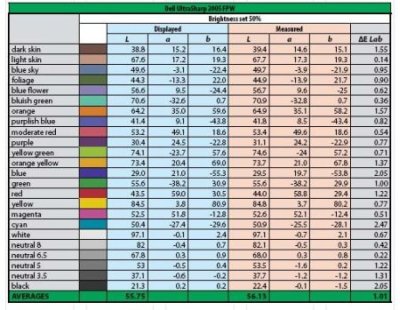articles/Monitors/kcdday-page1
The LCD's day has come! - part 1 of 1 2
by Mike McNamee Published 01/11/2005

Mark McNamee looks at wide options on the monitor front
"...Skin Tone had an error
of just 0.14 Lab ΔE, actually
too small to register..."
In early 2003 Hitachi made an announcement, followed by Sony in mid 2003, and Phillips in August 2003. Their effect had little impact at the time but suddenly things are starting to happen even if the driving legislation is being pulled and pushed, delayed and modified, stalled and killed in the way only Corporate America can. And the announcement in question? State legislation was brought before their lawmakers that the disposal of Cathode Ray Tubes (eg TVs and computer monitors) was no longer permissible by landfill means. Your average monitor contains between 4 and 8 pounds of lead in the glass and in radiation shielding around the electron gun. They estimate that there are between 300million and 680million computers stockpiled, awaiting disposal, and that by 2006 there will be 163,000 computers (3500 tons) for disposal each day! The announcements made by the big CRT makers was that they would phase out the production of CRTs in favour of LCDs. This has come to pass and you may be aware of the dramatic fall in the price of LCDs. The equally rapid rise in their quality might just have passed you by.
The LCD was once scorned by graphics professionals as not being up to the mark on colour accuracy, even though the obvious benefits of lower energy consumption, smaller desk footprint, lower weight, higher brightness in illuminated rooms and an absence of radiation were well recognised. One of the major bugbears was the changing luminance according to the angle of view (even though some makers tried to make it a virtue, for security, whilst you sat with your personal banker! This is all changing and the latest monitors to hit the market seem to fit the bill nicely for colour editing work.
In response to your Editor receiving ever-increasing numbers of requests for advice and mass confusion amongst the ranks, it was decided to put some statistics through the colour auditing process and put a mark in the sand (not literally - Ed.).
The monitor chosen was the Dell UltraSharp 2005 FPW 20" (henceforth "The Dell" for this feature). This is one of a new breed of LCD monitors with a wide format, close to the 16:10 ratio of the wide screen TV. In essence the shape of the Dell is akin to having two A4 sheets side by side, which has huge advantages for Photoshop users, as you can have your palettes tucked out of the way on the right and a full frame portrait format image on the left. LCDs are also amenable to being turned through 90°, so that you can, if you choose, have an A4 document opened at effectively A3 magnification and using every inch of your monitor real estate - try that with a 24" CRT.
The image turning is controlled by software. Even WACOM have kept ahead of the game and announced a new Intuos A5 Wide, which mimics the wide shape of either a wide screen monitor or a dual monitor system - more on that later.
Like all bright and sparky modern LCDs, the Dell looks very crisp, but to test it fully we used the X-Rite Monaco Optix XRPro to both calibrate and evaluate. We then took the data and ran it through the colour audit process that we use for paper testing,in the Paper Chase series.
You are currently on page 1 Contact Mike McNamee
1st Published 01/11/2005
last update 09/12/2022 14:55:30
More Monitors Articles
There are 0 days to get ready for The Society of Photographers Convention and Trade Show at The Novotel London West, Hammersmith ...
which starts on Wednesday 15th January 2025





